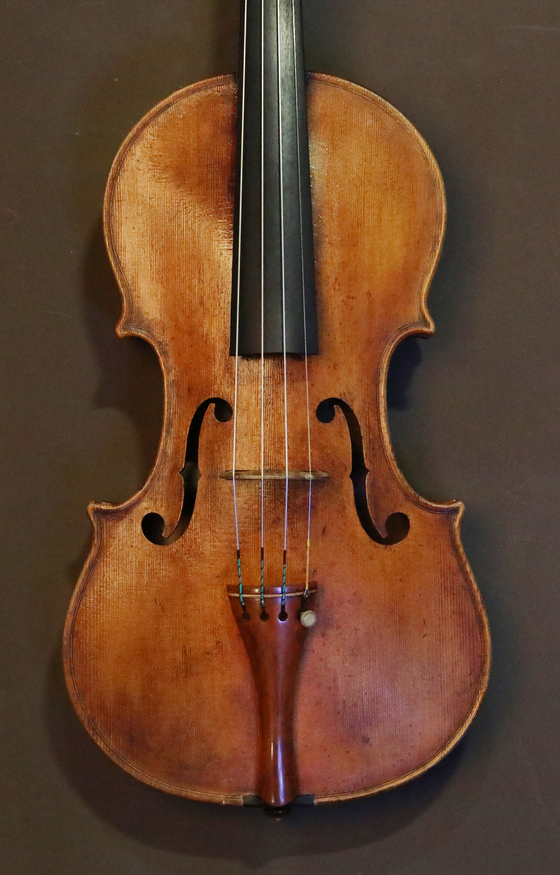It takes a village to make a world-class violin
![Luthier Kim Sin-seok works on making fusion musical instruments at his studio Shema String, located in Seocho-dong, southern Seoul. [PARK SANG-MOON]](https://koreajoongangdaily.joins.com/data/photo/2020/08/25/7a2c8c05-0d8d-413c-ba19-ec803ac4c3e8.jpg)
Luthier Kim Sin-seok works on making fusion musical instruments at his studio Shema String, located in Seocho-dong, southern Seoul. [PARK SANG-MOON]
“My ultimate goal is making a village that is Korea's answer to Italy’s Cremona, in which the entire village is dedicated to making string instruments,” said luthier Kim Sin-seok. A luthier is a craftsperson who specializes in building and repairing string instruments that have a neck and a sound box.
Having majored in violin, the artisan learned all the craft techniques needed for making string instruments from world-class maestros residing in Cremona.
Ever since returning from Italy in late 2014, Kim has been building handmade string instruments at his studio Shema String, located in Seocho-dong, southern Seoul.
![Kim has modernized ajaeng (traditional string instrument) to make it easier to play. [PARK SANG-MOON]](https://koreajoongangdaily.joins.com/data/photo/2020/08/25/e35fae17-5e2d-4c2f-b1d7-2d75f63b5d20.jpg)
Kim has modernized ajaeng (traditional string instrument) to make it easier to play. [PARK SANG-MOON]
Cremona is a small town nestled in the northern part of Italy and is best known for being home to many famous luthiers and their quality creations. The world’s most expensive instruments were created by the hands of some big-name luthiers including Andrea Amati, Carlo Bergonzi, Antonio Stradivari and Giuseppe Guarneri, who are all from Cremona.
The entire town has been involved in string instrument making for the last five centuries.
Kim entered college at the fairly late age of 35. Before he began his studies, Kim worked in multiple fields from fashion to interior design and music-related businesses in hopes of building up diverse experiences.
Kim’s talent for music came from his carpenter father who was excellent at playing janggo (a Korean percussion instrument).
Although Kim majored in violin in college, he found himself more interested in making instruments, rather than playing them. At first, he began learning techniques at a string instrument repair shop located in Gwangju. It was that stint that made him decide to go study abroad in Italy, the home of string instruments.
Kim considered the trip to Italy to be the last challenge in his life. He also thought it would be a chance to see whether the job of making string instruments would suit him.

![After reproducing a violin made by world-famous luthier Andrea Amati, Kim draws on the back and ribs of the violin. [PARK SANG-MOON]](https://koreajoongangdaily.joins.com/data/photo/2020/08/25/600a670f-a9e4-4e1c-887a-278016dc275a.jpg)
After reproducing a violin made by world-famous luthier Andrea Amati, Kim draws on the back and ribs of the violin. [PARK SANG-MOON]
Kim transferred as a sophomore to the Istituto d'Istruzione Superiore Antonio Stradivari Cremona in 2010.
At the school, students learn the overall procedures of making string instruments by studying topics such as music history, instrument building techniques, repair skills and sculpture. It was an undergraduate course, which takes five years to complete.
The most up-and-coming luthiers are graduates of the school.
Kim spent most of his day studying, only sleeping between four and six hours every day. His hectic schedule meant that even though he lived in Italy for five years, he had no time to take any trips within the country. He didn’t want to waste a moment away from his loved ones — his wife and two young children — who had remained in Korea.
Kim’s tireless efforts paid off as he met two masters who had the most influence on him in Cremona.
One is Daniel Scolari, who was a teacher at the school, and the other is Marco Nolli who ran an instrument-making studio. Scolari helped Kim in every way so that he could gain as much knowledge as possible from the school while Nolli, the world’s best maker of base violins, tried to pass on his “36 years of skills” to Kim.
Kim completed all the courses and handed in a contrabass as his graduation project. He was the first Asian student to work on a contrabass in the history of the school. He returned home in late 2014.
Upon arrival, Kim opened his studio in Seocho-dong and has been creating handmade violins and nurturing luthier hopefuls.
Of his various projects, Kim is most interested in modernizing traditional musical instruments of Korea and establishing a village in Korea that is similar to Cremona.
His series of fusion instruments are called Cheonjieum, meaning the instruments connect the sound of the sky and the earth. Kim wants to make new breeds of fusion instruments in his style as Italian luthier Carlo Bergonzi did during his lifetime.
When a set of fusion string instruments is ready, Kim hopes to launch a quartet and promote the beautiful sound of Korean musical instruments to the rest of the world.
The history of classical music in Korea is relatively shorter than that of other countries, but the skills of Korean luthiers are second to none, according to Kim. Korean luthiers have been sweeping international awards in recent years.
Korean luthiers are often said to be diligent and this attribute adds much-needed details to string instruments. Kim fantasizes about working with his peers when his dream, musical instrument-making village is complete.
To become one step closer to that dream, Kim plans to launch a competition for amateur luthiers in the near future, which he hopes will then evolve into a global event.
Kim has many other things on his to-do list such as building a school where children can learn craft techniques for string instruments and an exhibition hall where he can display all the quality, handmade string instruments.
Kim said he wants to someday see Korea lead the musical instrument-making market.
BY PARK SANG-MOON [moonpark@joongang.co.kr]










with the Korea JoongAng Daily
To write comments, please log in to one of the accounts.
Standards Board Policy (0/250자)